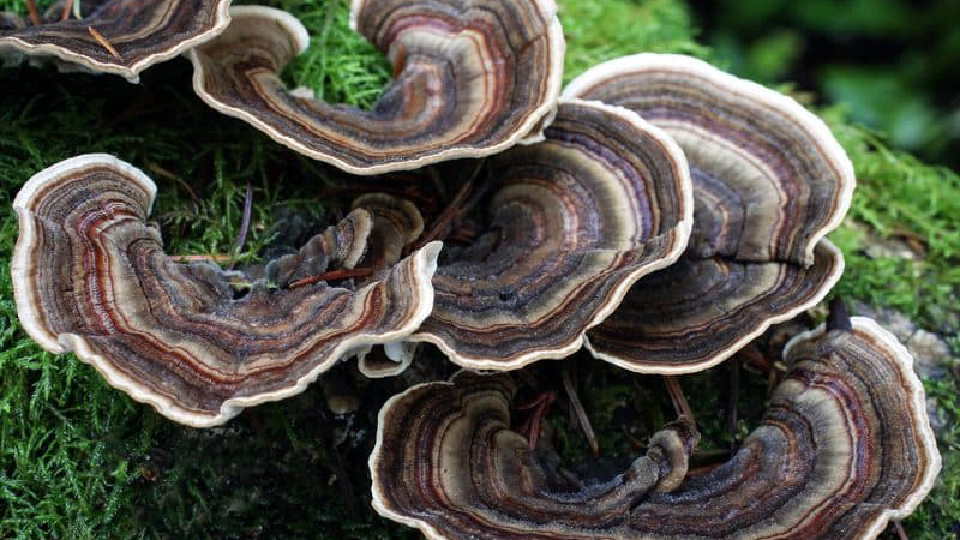Turkey Tail Mushroom Identification: Benefits, Uses, and More
Mastering Turkey Tail Mushroom Identification is crucial since it’s renowned for its medicinal properties, it used in traditional Chinese medicine for centuries. It’s rich in polysaccharide-K (PSK), a complex carbohydrate that has treated cancer and other ailments in Japan for over 30 years. Although identifying this mushroom can be challenging, it’s a valuable skill to possess.
Let’s dive into the world of turkey tail mushrooms and discover their unique characteristics and benefits! Whether you’re an experienced forager or new to mushroom hunting, identifying this mushroom can be a fulfilling experience. In this article, we’ll take you on an exciting journey to explore the fascinating world of turkey tail mushrooms.
In this article:
Turkey Tail Mushroom Identification
To identify the Turkey Tail Mushroom(Trametes versicolor), look for its distinct polypore appearance on decaying trees, stumps, and logs. It releases spores through tiny pores, unlike gilled mushrooms. Use our checklist for Turkey Tail Mushroom Identification and easily spot this unique fungus while foraging.
| ID Checklist | Description |
| Shape | Turkey tail mushrooms have a fan-like shape that resembles a turkey’s tail |
| Color | The top of the mushroom is often shades of brown, with distinct bands of color ranging from white to dark brown or even black |
| Underside | The underside of the mushroom has tiny white pores instead of gills |
| Texture | The cap and stem of the mushroom are tough and woody |
| Habitat | Turkey tail mushrooms grow on dead or dying trees, usually in forests or wooded areas |
| Spore print | Turkey tail mushrooms have white spores |
| Growing season | Generally grows May-December, but can be found year-round |
Turkey Tail Mushroom Identification Video
In this video, you’ll be taken on a close-up journey to explore the distinctive characteristics of the authentic turkey tail mushroom. You’ll get a detailed look at its velvety texture and concentric bands of vibrant colors. Additionally, you’ll witness how flexible and supple the mushroom should be. Get ready to discover the unique features of this incredible fungus!
Turkey Tail Lookalikes
When mushroom hunting, spotting Turkey Tail mushrooms is easy due to their distinct appearance with fan-shaped caps, unique zonation patterns, and firm texture, making them recognizable even to beginners.
However, it’s crucial to differentiate them from similar species, such as False Turkey Tails, Violet Toothed Polypores, and Multicolor Gilled Polypores, to avoid any accidents. To achieve this, let’s closely examine these mushrooms and learn how to distinguish them from genuine Turkey Tails through Turkey Tail Mushroom Identification.
1. False turkey tail
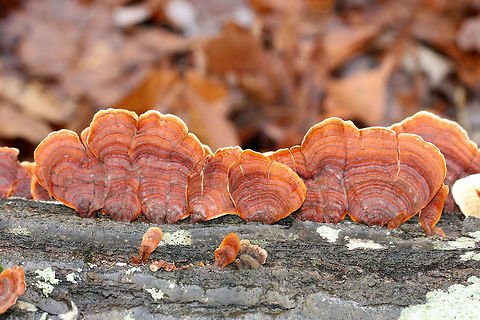
Mistaking the false turkey tail (Stereum ostrea) for the true turkey tail (Trametes versicolor) is common. False turkey tail mushrooms have a smooth surface and are slightly larger than the genuine ones. They typically come in colors like yellow, grey, or brown and have concentric circles. False turkey tails are found in North America, Europe, and Asia and grow on deadwood and decaying logs in shady, damp areas.
These mushrooms play a crucial role in the environment and are a source of food for wildlife. Additionally, they have been used in traditional medicine. Nature lovers will find false turkey tails fascinating due to their unique appearance, with concentric circles and a smooth, velvety texture. They make an excellent addition to any mushroom collection.
2. Violet toothed polypore
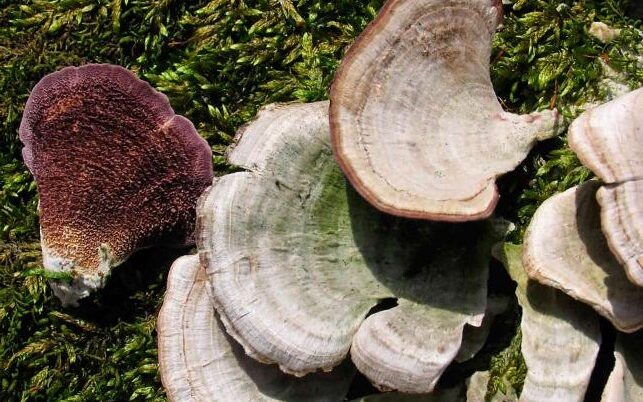
Violet toothed polypore (Trichaptum biforme), is a type of fungus that grows on hardwood trees in various parts of the world, including the eastern United States. Its fruiting body takes on a shelf-like shape that can be purple or grey in color. The fungus typically grows in clusters on dead or dying trees, and it has a furry texture on its cap. The underside of the cap is characterized by small pores that hold its spores.
While Turkey Tail mushrooms and Violet Toothed Polypore are closely related, there are key differences between the two. The Violet Toothed Polypore can be distinguished by its violet-colored cap and wrinkly surface, while Turkey Tail mushrooms have a smooth, leathery cap with concentric bands of color.
Interestingly, Violet Toothed Polypore is more nutritious than Turkey Tail mushrooms, containing higher levels of proteins, carbohydrates, and minerals. Moreover, it is rich in antioxidants that can help combat free radicals. This versatile mushroom can be consumed either raw or cooked, and has a variety of recipes that showcase its unique taste and texture.
3. Multicolor gilled polypore
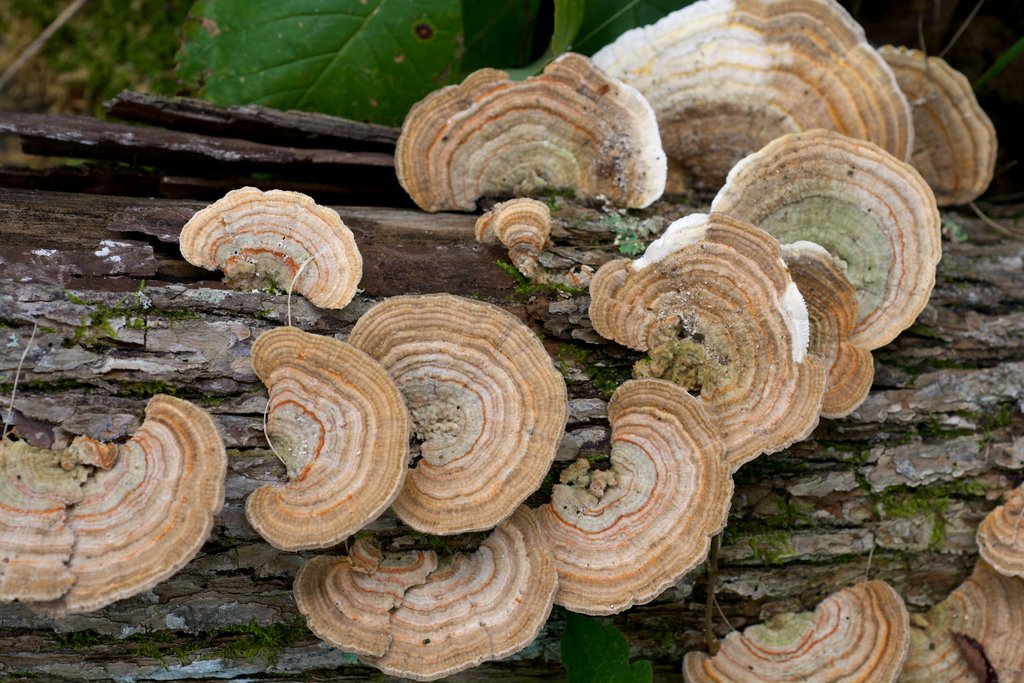
Multicolor gilled polypore, also known as Trametes betulina, is a worldwide fungus that belongs to the Polyporaceae family. It is typically found on dead or decaying hardwood trees and has a fan-shaped cap with various colors and gills on the underside. The colors can range from white to black, and it has a velvety texture and mild aroma.
Compared to turkey tail mushrooms, multicolor gilled polypore has true gills, a larger cap, and thicker flesh. It is edible and gaining popularity among mycologists and home cooks. It can be used in soups, stir-fries, or dried for tea due to its pleasant smell and mild flavor.
Turkey Tail Health Benefits
Turkey tail mushroom has a rich history in Traditional Chinese Medicine and provides numerous health benefits, including boosting the immune system to fighting cancer and supporting digestive health.
Research has found that turkey tail is rich in compounds like polysaccharides and triterpenes, which can enhance immunity. Additionally, its high antioxidant content helps protect the body against free radical damage.
And turkey tail has been found to reduce tumor size, inhibit cancer cell proliferation, and reduce the risk of cancer development. It may also aid in mitigating chemotherapy side effects[1].
For gastrointestinal problems, turkey tail can help reduce gut inflammation, enhance digestion, and alleviate irritable bowel syndrome symptoms. It may also provide relief from bloating and cramping[2].
Additional benefits like anti-aging properties, increasing energy levels, reducing stress, and enhancing mental clarity[3].
SUMMARY
Overall, turkey tail is a safe medicinal mushroom that can be consumed in various forms such as capsules, powders, teas, and coffees. If you’re seeking a natural way to support your health, turkey tail may be an excellent option to consider.
How to Use Turkey Tail
Turkey Tail mushrooms are incredibly versatile and can be used in various forms such as powders, teas, tinctures, or extracts. Making a powder is a simple process of drying the mushrooms and grinding them into a fine powder. For teas and tinctures, the dried mushrooms are soaked in hot water or alcohol. An extract can be made by boiling the mushrooms that have been soaked in alcohol.
Turkey Tail Chai Latte Recipe

Delicious Turkey Tail Chai Latte
Ingredients
Instructions
- Brew half a cup of turkey tail mushroom tea as per the instructions on the package.
- In a saucepan, combine the almond milk, brewed turkey tail tea, cinnamon, ginger, cardamom, cloves, and nutmeg.
- Heat the mixture over medium heat and whisk occasionally until it starts to simmer.
- Reduce the heat to low and let the mixture simmer for five minutes, stirring occasionally.
- Take off the heat and strain the mixture through a fine mesh strainer to remove any spice remnants.
- You can add honey or maple syrup to taste.
- Serve hot and enjoy!
The benefits of adding other herbs to this recipe
- Turkey tail mushrooms are rich in antioxidants and possess immune-boosting properties.
- Cinnamon is known to regulate blood sugar levels and has anti-inflammatory properties.
- Ginger has anti-inflammatory properties and aids in digestion.
- Cardamom is packed with antioxidants and aids in digestion.
- Cloves are anti-inflammatory and anti-bacterial.
- Nutmeg contains magnesium and has anti-inflammatory effects.
When you mix these ingredients, you can make a tasty and nutritious beverage that provides many health advantages.
Turkey Tail Mushroom Dosage
To achieve optimal results, it’s crucial to know the correct amount of turkey tail mushroom to take.
Experts in the scientific community have been debating about the appropriate dosage of turkey tail mushrooms. According to a recent study in the Mycology journal, 4 grams of turkey tail mushroom per day is the recommended dosage for treating cancer[4].
“Although turkey tail is non-toxic, its use in high doses or for extended periods of time may lead to digestive discomfort. I recommend a dosage of 1 to 3 grams per day for general immune support, and up to 9 grams per day for those with serious health conditions[5].”
– Renowned mycologist Paul Stamets
To achieve the best results from consuming turkey tail, it is crucial to take a suitable dose. Some studies suggest that higher doses may be more effective, but it is important to consult a healthcare provider before taking any supplement. Overdosing may result in side effects like nausea, vomiting, and diarrhea.
It is equally important to purchase a high-quality product from a GMP-certified facility to ensure that the product is pure and does not contain any contaminants or impurities. Always read the label carefully to make sure that it contains only Trametes versicolor and no other species of mushrooms.
Where to Find Turkey Tail Mushrooms
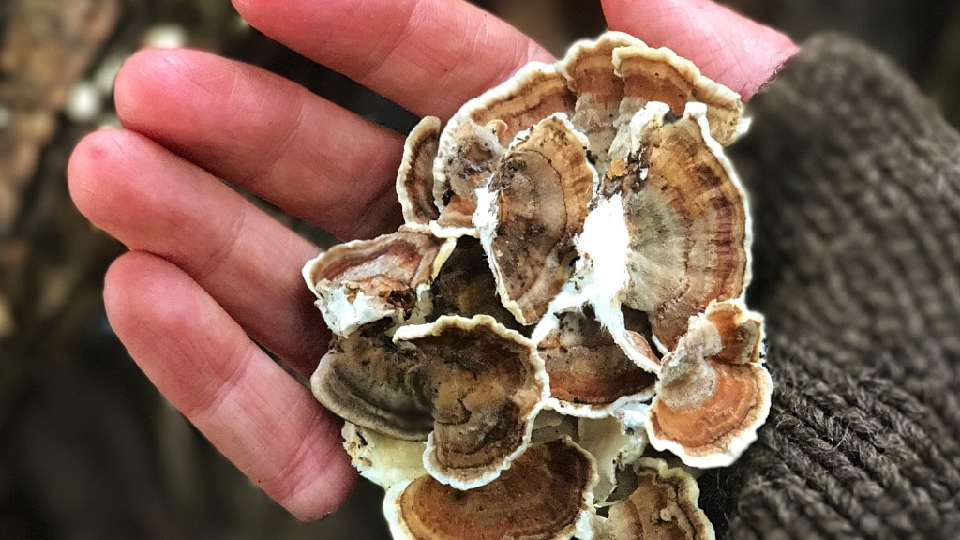
For mushroom enthusiasts, Turkey tail mushrooms are a species worth looking out for. They can be found in temperate regions across the globe, including North America, and grow on dead or decaying hardwoods like oak, maple, and beech, as well as conifers such as pine, fir, and spruce, and sometimes in soil near tree bases.
These mushrooms are most commonly found in late summer and fall, but they can be discovered at any time of the year. They can be seen on tree sides, logs, fallen branches, and occasionally on live trees.
With the right knowledge, finding Turkey tail mushrooms can be relatively easy, and they are a prized discovery for mycologists. Check dead or decaying hardwoods in temperate forests and woodlands to increase your chances of finding them.
FAQs
Are There Any Poisonous Look-Alikes to Turkey Tail Mushrooms?
Turkey Tail mushrooms (Trametes versicolor) have no known poisonous look-alikes. They are considered safe to identify and forage for, making them a beginner-friendly choice for mushroom enthusiasts. However, always use caution and consult a field guide or experienced forager when harvesting wild mushrooms to avoid potential risks.
How Can You Tell a Real Turkey Tail Mushroom?
To identify a real turkey tail mushroom, look for its fan-shaped or convex cap that has rings of color in shades of brown, red, and tan. The texture should be hard and leathery with a mild, earthy smell. Fresh mushrooms will have slightly sticky outer rings. These mushrooms grow in clusters on wood or wood debris and have short, white stems.
How Can You Tell a Turkey Tail From a Fake Turkey Tail?
Yes, you can tell the difference between a turkey tail from a fake turkey tail by paying attention to a few key features. Real turkey tails tend to have a thicker and feathery texture, with a curved shape and muted coloring. On the other hand, fake turkey tails are thinner and smoother, with straight shapes and overly vibrant coloring. By keeping these characteristics in mind, you can easily distinguish between real and fake turkey tails.
Is a False Turkey Tail Poisonous?
A false Turkey Tail mushroom (Stereum ostrea) is not poisonous, but it’s not typically consumed due to its tough and leathery texture. Unlike the true Turkey Tail (Trametes versicolor), it lacks the medicinal properties. However, it’s generally harmless if accidentally ingested and not considered toxic.
Can You Eat Turkey Tail Mushrooms?
Turkey tail mushrooms are edible and packed with vitamins, minerals, and antioxidants. They have a unique appearance with a fan-shaped cluster and thin concentric circles. Turkey tail has a slightly sweet and smoky flavor when cooked. They work well in soups, stir-fries, and stews and pair nicely with other mushrooms like shiitake or maitake.
How to Cook Turkey Tails?
To cook Turkey Tail mushrooms, follow these steps: Clean and slice them into thin pieces. Sauté with butter or oil, along with garlic and herbs, until they become tender. Use them as a side dish, in soups, or to flavor sauces. Ensure they’re well-cooked for the best taste and texture.
How to Make Turkey Tail Tea?
To make Turkey Tail tea, follow these steps: Boil water, add dried Turkey Tail mushroom pieces, and simmer for about 1 hour. Strain the liquid into a cup and enjoy. You can add honey or other flavors if desired. Adjust the amount of mushroom based on taste and intended benefits.
The Bottom Line
In conclusion, Identifying turkey tail mushrooms can be a fun and satisfying experience for those interested in foraging or mycology. These mushrooms are widespread and have a unique appearance with colorful concentric rings, making them easy to recognize.
However, it is crucial to be cautious when harvesting mushrooms and only collect those that have been positively identified. To ensure safe and responsible harvesting, it’s advisable to consult with an expert or use a reliable field guide.
By learning to identify and appreciate these fascinating fungi, we can deepen our understanding and appreciation of the natural world. It’s an excellent opportunity to connect with nature and learn about the important role mushrooms play in our ecosystem.
References
1. Coriolus (Trametes) versicolor mushroom to reduce adverse effects from chemotherapy or radiotherapy in people with colorectal cancer. Retrieved from https://www.researchgate.net/publication/365843743_Coriolus_Trametes_versicolor_mushroom_to_reduce_adverse_effects_from_chemotherapy_or_radiotherapy_in_people_with_colorectal_cancer
2. Polysaccharopeptide from Trametes versicolor blocks inflammatory osteoarthritis pain-morphine tolerance effects via activating cannabinoid type 2 receptor. Retrieved from https://www.sciencedirect.com/science/article/abs/pii/S0141813018360422
3. Deciphering the CNS anti-depressant, antioxidant and cytotoxic profiling of methanol and aqueous extracts of Trametes versicolor and molecular interactions of its phenolic compounds. https://www.ncbi.nlm.nih.gov/pmc/articles/PMC8568997/
4. Trametes versicolor (Turkey Tail Mushrooms) and the Treatment of Breast Cancer. https://www.ncbi.nlm.nih.gov/pmc/articles/PMC4890100/
5. The quote about turkey tail mushroom dosage comes from Paul Stamets, a well-known mycologist and author of several books on mushrooms, including “Mycelium Running: How Mushrooms Can Help Save the World” and “Growing Gourmet and Medicinal Mushrooms.” Stamets is also the founder of Fungi Perfecti, a company that specializes in promoting the cultivation and use of mushrooms for health and environmental benefits.

